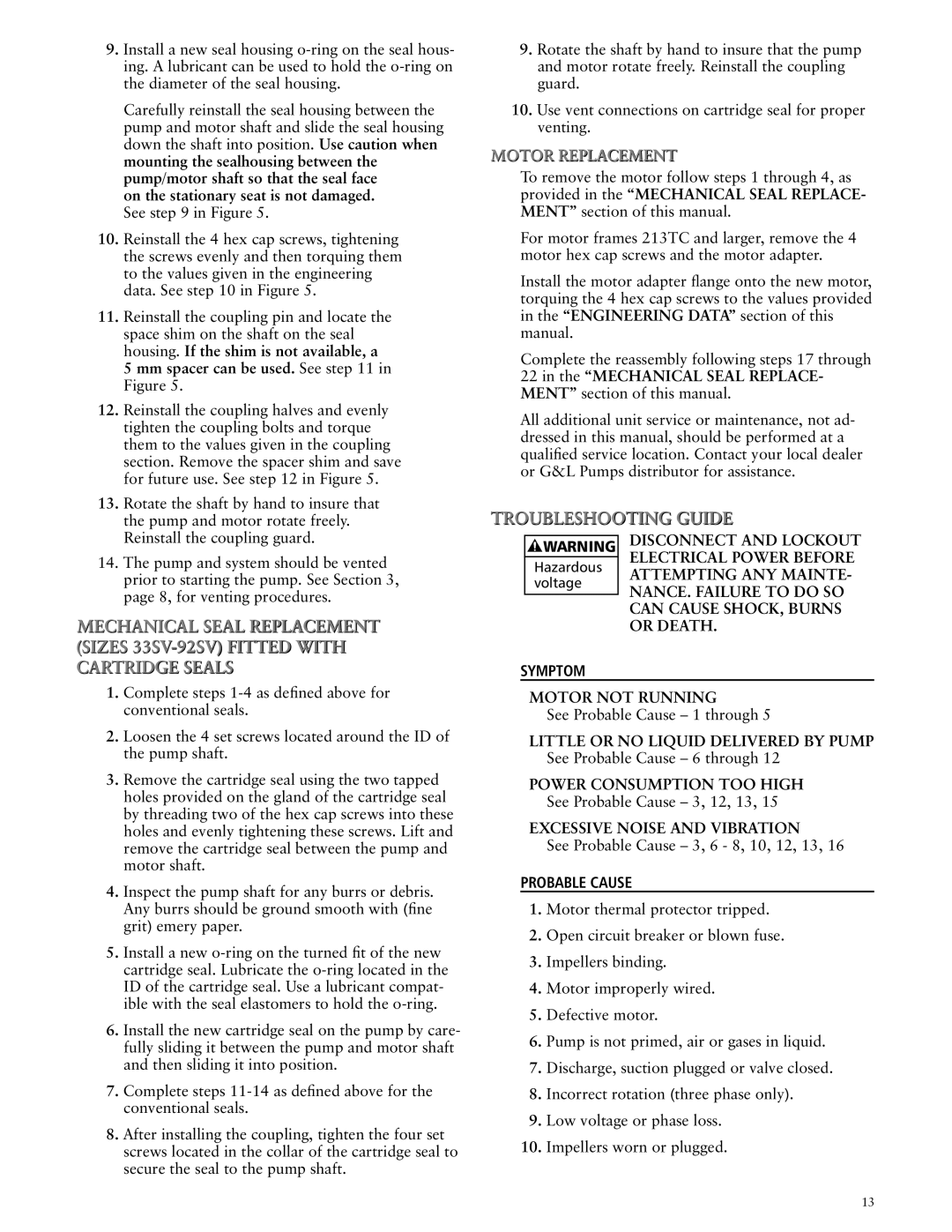
9. Install a new seal housing |
ing. A lubricant can be used to hold the |
the diameter of the seal housing. |
Carefully reinstall the seal housing between the |
pump and motor shaft and slide the seal housing |
down the shaft into position. Use caution when |
mounting the sealhousing between the |
pump/motor shaft so that the seal face |
on the stationary seat is not damaged. |
See step 9 in Figure 5. |
10. Reinstall the 4 hex cap screws, tightening |
the screws evenly and then torquing them |
to the values given in the engineering |
data. See step 10 in Figure 5. |
11. Reinstall the coupling pin and locate the |
space shim on the shaft on the seal |
housing. If the shim is not available, a |
5 mm spacer can be used. See step 11 in |
Figure 5. |
12. Reinstall the coupling halves and evenly |
tighten the coupling bolts and torque |
them to the values given in the coupling |
section. Remove the spacer shim and save |
for future use. See step 12 in Figure 5. |
13. Rotate the shaft by hand to insure that |
the pump and motor rotate freely. |
9.Rotate the shaft by hand to insure that the pump and motor rotate freely. Reinstall the coupling guard.
10.Use vent connections on cartridge seal for proper venting.
To remove the motor follow steps 1 through 4, as provided in the “MECHANICAL SEAL REPLACE- MENT” section of this manual.
For motor frames 213TC and larger, remove the 4 motor hex cap screws and the motor adapter.
Install the motor adapter flange onto the new motor, torquing the 4 hex cap screws to the values provided in the “ENGINEERING DATA” section of this manual.
Complete the reassembly following steps 17 through 22 in the “MECHANICAL SEAL REPLACE- MENT” section of this manual.
All additional unit service or maintenance, not ad- dressed in this manual, should be performed at a qualified service location. Contact your local dealer or G&L Pumps distributor for assistance.
Reinstall the coupling guard. |
14. The pump and system should be vented |
prior to starting the pump. See Section 3, |
page 8, for venting procedures. |
![]() WARNING
WARNING
Hazardous voltage
SYMPTOM
DISCONNECT AND LOCKOUT ELECTRICAL POWER BEFORE ATTEMPTING ANY MAINTE- NANCE. FAILURE TO DO SO CAN CAUSE SHOCK, BURNS OR DEATH.
1.Complete steps
2.Loosen the 4 set screws located around the ID of the pump shaft.
3.Remove the cartridge seal using the two tapped holes provided on the gland of the cartridge seal by threading two of the hex cap screws into these holes and evenly tightening these screws. Lift and remove the cartridge seal between the pump and motor shaft.
4.Inspect the pump shaft for any burrs or debris. Any burrs should be ground smooth with (fine grit) emery paper.
5.Install a new
6.Install the new cartridge seal on the pump by care- fully sliding it between the pump and motor shaft and then sliding it into position.
7.Complete steps
8.After installing the coupling, tighten the four set screws located in the collar of the cartridge seal to secure the seal to the pump shaft.
MOTOR NOT RUNNING
See Probable Cause – 1 through 5
LITTLE OR NO LIQUID DELIVERED BY PUMP See Probable Cause – 6 through 12
POWER CONSUMPTION TOO HIGH
See Probable Cause – 3, 12, 13, 15
EXCESSIVE NOISE AND VIBRATION
See Probable Cause – 3, 6 - 8, 10, 12, 13, 16
PROBABLE CAUSE
1.Motor thermal protector tripped.
2.Open circuit breaker or blown fuse.
3.Impellers binding.
4.Motor improperly wired.
5.Defective motor.
6.Pump is not primed, air or gases in liquid.
7.Discharge, suction plugged or valve closed.
8.Incorrect rotation (three phase only).
9.Low voltage or phase loss.
10.Impellers worn or plugged.
13
